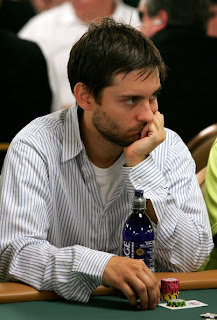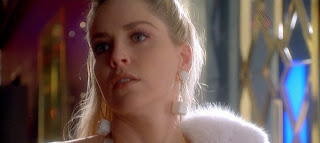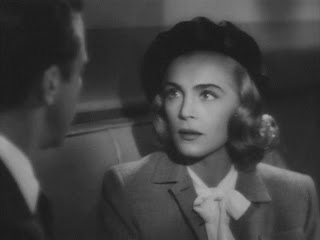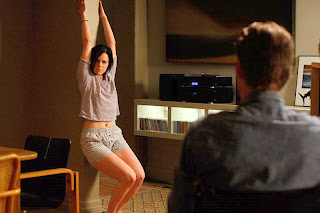 Lizabeth Scott and Van Heflin in "The Strange love of Martha Ivers" (1946) directed by Lewis Milestone
Lizabeth Scott and Van Heflin in "The Strange love of Martha Ivers" (1946) directed by Lewis Milestone "Scott was groomed as a troubled “good girl” first as Toni Marachek, a wrong-side-of-the-tracks-with-a-heart-of-gold type, in The Strange Love of Martha Ivers (1946). As per Wallis’s plan, director of photography Victor Milner (often overshadowed in the scheme of things at Paramount by lens legend John Seitz, but an extremely accomplished craftsman in his own right) gave Scott a lavish glamour tableau, especially in her silent reaction shots.
"Scott was groomed as a troubled “good girl” first as Toni Marachek, a wrong-side-of-the-tracks-with-a-heart-of-gold type, in The Strange Love of Martha Ivers (1946). As per Wallis’s plan, director of photography Victor Milner (often overshadowed in the scheme of things at Paramount by lens legend John Seitz, but an extremely accomplished craftsman in his own right) gave Scott a lavish glamour tableau, especially in her silent reaction shots. The fact that she didn’t register even a scintilla of streetwise sense in her characterization of an ostensible “blue collar girl” was glossed over. Her earlier career as a model was sent up in a scene where she gives Van Heflin a tour of her new outfit—complete with removable skirt.
The fact that she didn’t register even a scintilla of streetwise sense in her characterization of an ostensible “blue collar girl” was glossed over. Her earlier career as a model was sent up in a scene where she gives Van Heflin a tour of her new outfit—complete with removable skirt. Lizabeth Scott relaxing on the set of "The Strange love of Martha Ivers" (1946)
Lizabeth Scott relaxing on the set of "The Strange love of Martha Ivers" (1946)The “eye candy” approach worked well, and Martha Ivers was a hit—more due to the tense triangle between Van Heflin, Barbara Stanwyck, and Kirk Douglas, but Scott was swept along for the ride.
 As a result, Wallis gave her the lead in the grimly gay sagebrush noir Desert Fury, a film designed to take full advantage of Scott’s youthful glow. An ultra-rare Technicolor noir, Desert Fury (1947) showcased Arizona locations and a rapturous color scheme coordinated to Scott’s complexion, facial expressions—even her wardrobe. She’s no longer incongruously hardscrabble; instead she’s incongruously innocent and impetuous at the same time, lurching into a hornet’s nest of past pain and homoerotic reckonings.
As a result, Wallis gave her the lead in the grimly gay sagebrush noir Desert Fury, a film designed to take full advantage of Scott’s youthful glow. An ultra-rare Technicolor noir, Desert Fury (1947) showcased Arizona locations and a rapturous color scheme coordinated to Scott’s complexion, facial expressions—even her wardrobe. She’s no longer incongruously hardscrabble; instead she’s incongruously innocent and impetuous at the same time, lurching into a hornet’s nest of past pain and homoerotic reckonings. At times it seems she’s being pursued more passionately by her own mother (Mary Astor) than by the two men who are, in theory at least, rivals for her favors (Burt Lancaster and John Hodiak). Too well bred to be truly bratty, Scott has to settle for simmering in a film that desperately needs something more fiery than the endless innuendo it dispenses.
At times it seems she’s being pursued more passionately by her own mother (Mary Astor) than by the two men who are, in theory at least, rivals for her favors (Burt Lancaster and John Hodiak). Too well bred to be truly bratty, Scott has to settle for simmering in a film that desperately needs something more fiery than the endless innuendo it dispenses. When Rita Hayworth backed out of playing Coral Chandler in Dead Reckoning (1947), Scott pestered Wallis to make a loan-out deal. He did so, but with a good deal of reluctance: the screenplay was muddled, much more so than the type of dark films Wallis preferred to make (unlike other “noir auteurs”, Wallis eschewed flashback narration, only allowing a bare minimum of it in I Walk Alone).
When Rita Hayworth backed out of playing Coral Chandler in Dead Reckoning (1947), Scott pestered Wallis to make a loan-out deal. He did so, but with a good deal of reluctance: the screenplay was muddled, much more so than the type of dark films Wallis preferred to make (unlike other “noir auteurs”, Wallis eschewed flashback narration, only allowing a bare minimum of it in I Walk Alone). For Lizabeth Scott, the role was clearly confusing, even though she clearly understood the idea that Coral was supposed to be struggling with her own nature. The “good bad girl” concept got a strenuous and ultimately tenuous workout here: Coral Chandler is a “bad good bad good bad” girl (if one has counted the script flipflops accurately). Scott is so exhausted at the end of the film that she goes wooden, capitulating to a hopelessly muddled role after a valiant attempt to tame it.
For Lizabeth Scott, the role was clearly confusing, even though she clearly understood the idea that Coral was supposed to be struggling with her own nature. The “good bad girl” concept got a strenuous and ultimately tenuous workout here: Coral Chandler is a “bad good bad good bad” girl (if one has counted the script flipflops accurately). Scott is so exhausted at the end of the film that she goes wooden, capitulating to a hopelessly muddled role after a valiant attempt to tame it.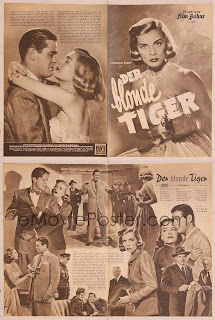 It’s probably no wonder that Scott threw herself into the role of Jane Palmer with a sense of gusto— was she working out her frustrations with Wallis when she made the astonishing transformation from housewife to murderess in Too Late for Tears (1949).
It’s probably no wonder that Scott threw herself into the role of Jane Palmer with a sense of gusto— was she working out her frustrations with Wallis when she made the astonishing transformation from housewife to murderess in Too Late for Tears (1949). There is little duality to be found in Jane Palmer, though Roy Huggins’ script gives her some Phyllis Dietrichson -like backstory as a kind of belated explanation. In a few brief scenes, we see Jane embrace her obsession and grow into a persona that clearly eschews the notion of marriage. We get a brief glimpse of what femme fatales do when they actually get away with their misdeeds —they become feminist free agents.
There is little duality to be found in Jane Palmer, though Roy Huggins’ script gives her some Phyllis Dietrichson -like backstory as a kind of belated explanation. In a few brief scenes, we see Jane embrace her obsession and grow into a persona that clearly eschews the notion of marriage. We get a brief glimpse of what femme fatales do when they actually get away with their misdeeds —they become feminist free agents. Lizabeth Scott and Dan Duryea as Jane Palmer and Danny Fuller in "Too late for tears" (1949) directed by Byron Haskin
Lizabeth Scott and Dan Duryea as Jane Palmer and Danny Fuller in "Too late for tears" (1949) directed by Byron HaskinScott, who has up to this point been a bit too overt in displaying the roughening edges of her character’s pose of gentility, achieves a new level of relaxation in these brief scenes —a “character state of mind” that she will return to in later noirs. For a little while, at least, Jane Palmer has defied the patriarchy in all of its forms —smarmy but smothering (as embodied in her husband Alan, played by Arthur Kennedy), lowdown and conniving (Dan Duryea in a hammy turn as grifter Danny Fuller, who knows the scoop about the $60,000 that Jane is trying to hold on to), smirky and covert (Don DeFore, a most avuncular avenger). It is a character a good bit ahead of its time" -Lizabeth Scott: Noir's Quicksilver Anti-Heroine" by Anastasia Lin (Special to the Sentinel, Fall 2010)
More memorable actresses who played femme-fatales in the Golden Age (1940's-1950's):
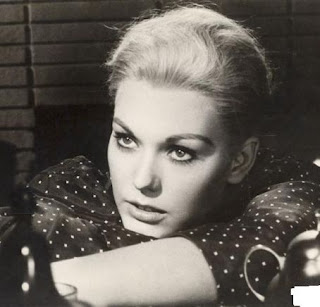 Kim Novak as Madeleine Elster in "Vertigo" (1958) directed by Alfred Hitchcock
Kim Novak as Madeleine Elster in "Vertigo" (1958) directed by Alfred Hitchcock Rita Hayworth
Rita Hayworth Claire Trevor
Claire Trevor Kaaren Verne
Kaaren Verne Ida Lupino
Ida Lupino Julie Bishop
Julie Bishop Ava Gardner
Ava Gardner Jane Greer
Jane Greer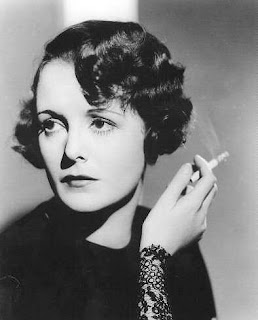 Mary Astor
Mary Astor Gail Patrick
Gail Patrick Mamie Van Doren
Mamie Van Doren Barbara Patyon
Barbara Patyon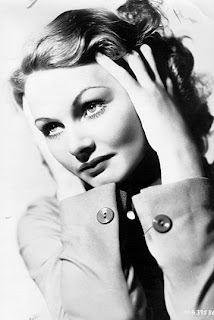 Sylvia Sidney
Sylvia Sidney Madeleine Carroll
Madeleine Carroll Jeanne Crain
Jeanne Crain Dolores Moran
Dolores Moran Lana Turner
Lana Turner Gene Tierney
Gene Tierney Peggy Cummins
Peggy Cummins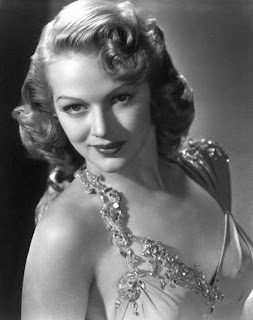 Virginia Grey
Virginia Grey Gloria Grahame
Gloria Grahame Audrey Totter
Audrey Totter Lizabeth Scott and Victor Mature as Liza Wilson and Pete Wilson in "Easy Living" (1949) directed by Jacques Tourneur
Lizabeth Scott and Victor Mature as Liza Wilson and Pete Wilson in "Easy Living" (1949) directed by Jacques Tourneur"Based on "Education of the Heart" a short story by Irwin Shaw, Easy Living (1949) is a peculiar mixture of football movie, a noir sexual relationship, and tentative romance.
 The best reason for the viewer is his very ambitious wife, Liza (Lizabeth Scott) who is an interior decorator "with no taste and no talent" but who attracts a powerful patron (one only too pleased to snatch her up before his son does), Howard Vollmer (Art Baker). The pouty, husky-voiced Lizabeth Scott was one of the greatest (and greediest-seeming) noir femme fatales (The Strange Love of Martha Ivers, I Walk Alone, Dead Reckoning, Pitfall, Too Late for Tears). Apparently the censors cut her part, but there was no doubt in my mind that her success was arranged by Vollmer in return for "sexual favors."
The best reason for the viewer is his very ambitious wife, Liza (Lizabeth Scott) who is an interior decorator "with no taste and no talent" but who attracts a powerful patron (one only too pleased to snatch her up before his son does), Howard Vollmer (Art Baker). The pouty, husky-voiced Lizabeth Scott was one of the greatest (and greediest-seeming) noir femme fatales (The Strange Love of Martha Ivers, I Walk Alone, Dead Reckoning, Pitfall, Too Late for Tears). Apparently the censors cut her part, but there was no doubt in my mind that her success was arranged by Vollmer in return for "sexual favors." Tourneur directed one of the greatest noirs, "Out of the Past" and the stylish low-budget "Cat People" and "I Walked with a Zombie." His output strikes me as an impressive counterexample of "auteur theory." This makes me credit producer Val Lewton for "Cat People" (and what is good in "Zombie" and "The Leopard Man"), Burt Lancaster for the campy swashbuckler, "The Flame and the Arrow," and to consider "Out of the Past" a miracle. "Easy Living" is undistinguished except for Lizabeth Scott's performance and Roy Webb's (I Married a Witch, My Favorite Wife, Out of the Past) achey musical score". Source: www.epinions.com
Tourneur directed one of the greatest noirs, "Out of the Past" and the stylish low-budget "Cat People" and "I Walked with a Zombie." His output strikes me as an impressive counterexample of "auteur theory." This makes me credit producer Val Lewton for "Cat People" (and what is good in "Zombie" and "The Leopard Man"), Burt Lancaster for the campy swashbuckler, "The Flame and the Arrow," and to consider "Out of the Past" a miracle. "Easy Living" is undistinguished except for Lizabeth Scott's performance and Roy Webb's (I Married a Witch, My Favorite Wife, Out of the Past) achey musical score". Source: www.epinions.com Jane Greer Among Screen's Great Villainesses in Out of the Past
Jane Greer Among Screen's Great Villainesses in Out of the Past“Along with Barbara Stanwyck in Double Indemnity” Ursini notes in his DVD commentary, “[Greer] is probably the most important of the [noir genre's] femme fatales, influencing people all the way down to Sharon Stone in Basic Instinct and Faye Dunaway in Chinatown.”
 Out of the Past glides between the present day of 1947 and flashback to tell the dark tale of former private detective Jeff Bailey (Mitchum).
Out of the Past glides between the present day of 1947 and flashback to tell the dark tale of former private detective Jeff Bailey (Mitchum).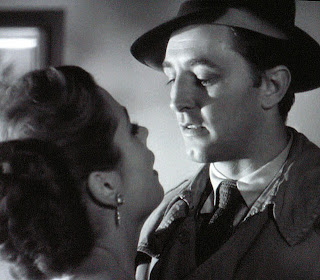 His back story is revealed in a lengthy flashback. Three years earlier, Whit sent Bailey to retrieve a girlfriend, Kathie, who'd shot him and made off with $40,000. Bailey traced her to Acapulco and – no big surprise here – they became involved. She denied stealing the money and, well, she certainly seemed sincere.
His back story is revealed in a lengthy flashback. Three years earlier, Whit sent Bailey to retrieve a girlfriend, Kathie, who'd shot him and made off with $40,000. Bailey traced her to Acapulco and – no big surprise here – they became involved. She denied stealing the money and, well, she certainly seemed sincere. Daniel Mainwaring Wrote the Screenplay, Based on His Novel: The intricately-plotted screenplay was written by Daniel Mainwaring (under the name Geoffrey Homes), based on his novel, Build My Gallows High. And beyond the careful structure, Mainwaring’s script features countless great lines. Like when Jeff tells Kathie, “You’re like a leaf that the wind blows from one gutter to another". Source: www.suite101.com
Daniel Mainwaring Wrote the Screenplay, Based on His Novel: The intricately-plotted screenplay was written by Daniel Mainwaring (under the name Geoffrey Homes), based on his novel, Build My Gallows High. And beyond the careful structure, Mainwaring’s script features countless great lines. Like when Jeff tells Kathie, “You’re like a leaf that the wind blows from one gutter to another". Source: www.suite101.com "Dead Reckoning", "In a lonely place" and "The Desperate Hours" reveal even more clearly how the ongoing renegotiation of Bogart's persona after World War II charts the transformation of the 1940's film noir tough guy into the fifties psychopath, according to Freedman: "a violent male, sexual criminal".
"Dead Reckoning", "In a lonely place" and "The Desperate Hours" reveal even more clearly how the ongoing renegotiation of Bogart's persona after World War II charts the transformation of the 1940's film noir tough guy into the fifties psychopath, according to Freedman: "a violent male, sexual criminal". Bogart's fifties films demonstrate that his virility itself is what disturbs his characters' relations with women and other men, his toughness functioning as a mechanism of sexual regulation supporting the authority of postwar hegemonic masculinity. In Joan Mellen's view, this representation of masculinity made Bogart the star who best personified manliness for the 1940's: "Bogart's Sam Spade is supremely masculine because he's his own man". As weaker men fall to the bottom, the tough hero rises to the top, in validation of his brand of masculinity.
Bogart's fifties films demonstrate that his virility itself is what disturbs his characters' relations with women and other men, his toughness functioning as a mechanism of sexual regulation supporting the authority of postwar hegemonic masculinity. In Joan Mellen's view, this representation of masculinity made Bogart the star who best personified manliness for the 1940's: "Bogart's Sam Spade is supremely masculine because he's his own man". As weaker men fall to the bottom, the tough hero rises to the top, in validation of his brand of masculinity. As Frank Krutnik demonstrates in his study of film noir, what then overrides the hostility otherwise resulting from this competition for power is a sense shared by all the men in the hierarchical structure that femininity -the dangerous female with the gun- is the great unsolved mystery. -"Masked men: masculinity and the movies in the fifties" by Steven Cohan
As Frank Krutnik demonstrates in his study of film noir, what then overrides the hostility otherwise resulting from this competition for power is a sense shared by all the men in the hierarchical structure that femininity -the dangerous female with the gun- is the great unsolved mystery. -"Masked men: masculinity and the movies in the fifties" by Steven Cohan Robert Ryan (1909-1973)
Robert Ryan (1909-1973)"RKO was the smallest of the five major studios and while it didn’t have the biggest stars, in the late 1940s and early ’50s it had a sterling lineup of tough guys and femmes fatales well known to lovers of classic noir. Robert Mitchum was at the studio with Ryan (they made several films together, including “The Racket”) alongside those great dames Ida Lupino and Gloria Grahame. At RKO Ryan broke out with his supporting turn in Edward Dmytryk’s “Crossfire” (1947) as Montgomery, an anti-Semitic soldier who, in a fit of hate, beats a Jewish man to death. Also along for the nasty ride: Mitchum, Grahame and Robert Young. (Ryan served as a drill sergeant in the Marines near the end of World War II.)
 Robert Ryan made “The Set-Up” one of his favorites and most indelible films, two years later. Directed by Robert Wise (who had edited “Citizen Kane”), “The Set-Up” is a tight, intensely moving, pocket-size masterwork about Stoker Thompson, a washed-up, 35-year-old heavyweight who believes he’s just “one punch away” from changing his lousy luck. Part redemption story, part romance
Robert Ryan made “The Set-Up” one of his favorites and most indelible films, two years later. Directed by Robert Wise (who had edited “Citizen Kane”), “The Set-Up” is a tight, intensely moving, pocket-size masterwork about Stoker Thompson, a washed-up, 35-year-old heavyweight who believes he’s just “one punch away” from changing his lousy luck. Part redemption story, part romance (his wife is played by Audrey Totter), the film unfolds in close to real time and takes place in the cruelly named Paradise City. Ryan, all muscle, sinew and heart-rending longing, slugs through one punishing round after another — look for the photographer Weegee hitting the bell as the timekeeper — creating a portrait of a man who endures ghastly physical punishment on his way to redemption.
(his wife is played by Audrey Totter), the film unfolds in close to real time and takes place in the cruelly named Paradise City. Ryan, all muscle, sinew and heart-rending longing, slugs through one punishing round after another — look for the photographer Weegee hitting the bell as the timekeeper — creating a portrait of a man who endures ghastly physical punishment on his way to redemption. In an earlier Hollywood age he might have had a more nuanced career and been able, like Bogart before him, to move away from playing so many heavies. But in 1948 old Hollywood was dealt a death blow when the Supreme Court forced the studios out of the exhibition business, changing everything.
In an earlier Hollywood age he might have had a more nuanced career and been able, like Bogart before him, to move away from playing so many heavies. But in 1948 old Hollywood was dealt a death blow when the Supreme Court forced the studios out of the exhibition business, changing everything. “Bob Ryan is a marvelous person,” Renoir said decades after they worked together. “But he was unlucky in happening on a period in which the American cinema was in full cry after war epics — all of them highly successful.” In a 1971 interview Ryan reflected on the Hollywood he had known. The conformity of the material was a problem, true. But the old system had virtues, he said: studios “would gamble once in a while on an offbeat picture.” As important, they were a training ground for young actors. “We all had to go to film school, and we worked in hordes of pictures — B pictures — which were shot very fast” and were, he said, an “amazing experience.”
“Bob Ryan is a marvelous person,” Renoir said decades after they worked together. “But he was unlucky in happening on a period in which the American cinema was in full cry after war epics — all of them highly successful.” In a 1971 interview Ryan reflected on the Hollywood he had known. The conformity of the material was a problem, true. But the old system had virtues, he said: studios “would gamble once in a while on an offbeat picture.” As important, they were a training ground for young actors. “We all had to go to film school, and we worked in hordes of pictures — B pictures — which were shot very fast” and were, he said, an “amazing experience.” Robert Ryan and Ida Lupino in Nicolas Ray’s On Dangerous Ground (1952)
Robert Ryan and Ida Lupino in Nicolas Ray’s On Dangerous Ground (1952)And what about the new system, the interviewer asked. “Speaking from the actor’s point of view,” Ryan said, “it’s not anywhere near as enduring. A kid will make a hit in a couple of movies and then you may not hear of him again.” Nonetheless he believed the movies had gotten better and a few years earlier had starred in one of his best, “The Wild Bunch” (1969), as a terribly sad, worn-out former outlaw hunting his old partner (William Holden)". Source: www.nytimes.com
